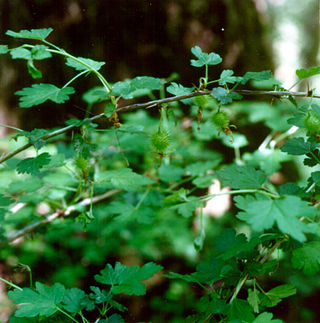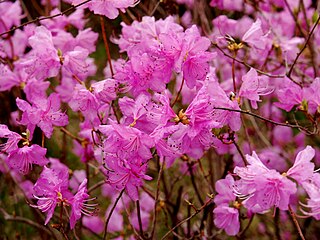
Rhododendron is a very large genus of about 1,024 species of woody plants and in the heath family (Ericaceae). They can be either evergreen or deciduous. Most species are native to eastern Asia and the Himalayan region, but smaller numbers occur elsewhere in Asia, and in North America, Europe and Australia.

Rhododendron canadense, the rhodora or Canada rosebay, is a deciduous flowering shrub that is native to northeastern North America.

Rhododendron occidentale, the western azalea or California azalea, is one of two deciduous Rhododendron species native to western North America. The western azalea is known to occur as far north as Lincoln and Douglas Counties in Oregon and as far south as the mountains of San Diego county. Typically found in the coastal ranges of western North America, it also grows in the Cascade and Sierra Nevada mountain ranges, but is not known east of them.

Rhododendron luteum, the yellow azalea or honeysuckle azalea, is a species of flowering plant in the heath family Ericaceae, native to southeastern Europe and southwest Asia. In Europe, it occurs from southern Poland and Austria, south through the Balkans, and east to southern Russia; and in Asia, east to the Caucasus.

Rhododendron schlippenbachii, the royal azalea, is a species of Rhododendron native to the Korean Peninsula and adjacent regions of Northeast China, Japan, and the Russian Far East. It is the dominant understory shrub in many Korean hillside forests, growing at 400–1,500 m (1,300–4,900 ft) altitude.

Ribes echinellum, the Miccosukee gooseberry, is a very rare North American shrub in the currant family, native to the southeastern United States. It has only a few known populations. The Florida populations were discovered first, in 1924 at Lake Miccosukee. The South Carolina populations were found in 1957 and 1981, and the first is protected at Steven's Creek Heritage Preserve.

Rhododendron calendulaceum, the flame azalea, is a species of Rhododendron. It is a deciduous shrub that grows up to 120–450 cm tall. This species of Rhododendron is native to the Appalachian Mountains in the eastern United States, ranging from southern Pennsylvania and Ohio to northern Georgia. It may be extirpated from Pennsylvania and Alabama. It occurs naturally in mixed deciduous forests and is typically found in woodland slopes and mountain balds in the Appalachians, where it prefers dry and rocky mountain woods. The inflorescences of Rhododendron calendulaceum are visited by many animals such as bees, butterflies, hummingbirds and small mammals. It is a popular cultivated plant due to its bright yellow, orange or red flowers.

Rhododendron macrophyllum, the Pacific rhododendron, California rosebay, California rhododendron, coast rhododendron or big leaf rhododendron, is a large-leaved species of Rhododendron native to the Pacific Coast of North America. It is the state flower of Washington.

Rhododendron viscosum, the swamp azalea, clammy azalea or swamp honeysuckle, is a species of flowering plant in the heath family Ericaceae. This deciduous shrub, growing to 2.5 m (8.2 ft) tall and broad, is native to the eastern United States. It has rounded matt green leaves. In early summer it produces funnel-shaped white flowers flushed pink. The flowers have prominent stamens and are strongly fragrant.

Rhus aromatica, the fragrant sumac, is a deciduous shrub in the family Anacardiaceae native to North America. It is found in southern Canada and nearly all of the lower 48 states except peninsular Florida.

Rhododendron periclymenoides, the pink azalea or pinxter flower, is a species of shrub in the heath family Ericaceae. It is native to eastern North America, where it is widespread from Alabama to New Hampshire. It is often found in riparian areas, in wet to dry forests.

Rhododendron arborescens, also known as smooth azalea or sweet azalea, is a species of flowering plant in the family Ericaceae, native to the eastern seaboard of the United States.

Rhododendron austrinum is a species of flowering plant in the heath family known by the common names Florida flame azalea, honeysuckle azalea, southern yellow azalea, and orange azalea. It is native to the southern United States, where it can be found in Alabama, Florida, Georgia, and Mississippi. It is also a common ornamental plant.

Rhododendron vaseyi is a species of flowering plant in the heath family known by the common name pinkshell azalea. It is endemic to the Appalachian highlands of North Carolina in widely scattered locations. While there is a main center of distribution west of Asheville, there is also a large population on Grandfather Mountain, in the northwestern corner of the state.

Rhododendron minus var. minus, the Carolina azalea or Carolina rhododendron, is a rhododendron species native to the mountains of North Carolina, South Carolina, Tennessee, and Northeast Georgia. It is commonly known as Rhododendron carolinianum in the horticultural trade.

Rhododendron molle (羊踯躅) is a rhododendron species native to China and Japan, where it grows at altitudes of sea level to 2500 meters. This deciduous shrub grows to 50–200 cm (20–79 in) in height, with leaves that are oblong to oblong-lanceolate, 5–11 by 1.5–3.5 cm in size. The flowers are yellow with dark red flecks.

Rhododendron mucronulatum, the Korean rhododendron or Korean rosebay, is a rhododendron species native to Korea, Mongolia, Russia, and parts of northern China. It is a deciduous shrub that grows to 1–2 m (3.3–6.6 ft) in height, with elliptic or elliptic-lanceolate leaves, 3–7 cm long by 1–3.5 cm wide. The reddish-purple flowers appear in late winter or early spring, often on the bare branches before the foliage unfurls. It inhabits forested regions at 1,600–2,300 m (5,200–7,500 ft).

Rhododendron prinophyllum, the early azalea, is a rhododendron species native to the eastern and southern United States. It is a deciduous shrub that grows 4 to 8 feet in height. Flowers are pink.

Rhododendron flammeum, the Piedmont azalea or Oconee azalea, is a plant species native to the US states of Georgia and South Carolina. It is found in dry woods and stream bluffs at elevations less than 500 m. The common name is taken from Oconee County, South Carolina.

North American azaleas are flowering shrubs in the genus Rhododendron, section Pentanthera, subsection Pentanthera, so named because they all have five stamens. Most are in the United States, with one species found in Canada and one being found in Mexico. North American azaleas are commonly confused with azaleas of Asian origin, the evergreen azaleas. North American azaleas are deciduous and produce two types of buds. One is a larger and produces about 20 flowers while the other bud produces a leafy shoot. The flower color, fragrance, and number of stamens vary among species.























